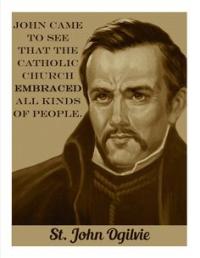
Feast day: 14 October
St John Ogilvie was the eldest son of Walter Ogilvie, a respected Calvinist, who owned the estate of Drumnakeith in Banffshire. His family was partly Roman Catholic and partly Presbyterian. At the age of twelve John was sent to Europe to be educated. He attended a number of Catholic institutions, under the Benedictines at Regensburg and with the Jesuits at Olmutz and Brunn in Moravia.
He decided to become a Catholic and was received into the church at the age of seventeen by Cornelius a Lapide SJ, professor of Sacred Scripture at the Scots College in Leuven (now in Belgium). When that college closed owing to financial difficulties, John went first to the Benedictines and then to the Jesuits at Olomouc. He joined the Society of Jesus in 1599 at Brno in Moravia and was ordained a priest in 1613. He studied philosophy at Graz and Vienna, and theology at Olomouc. After ordination he served in Rouen in Normandy, where he made repeated requests to minister to the few remaining Catholics in the Glasgow area. After the Scottish Reformation in 1560 it had become illegal to preach, prosletyse or promote Catholicism.
It was hoped that, because of his family background, some Catholic nobles would help him in his work; but none did. He went to London, then back to Paris and finally returned to Scotland disguised as a horse-trader named John Watson. There he began to preach in secret, offering mass in private homes. The ministry would last less than a year. In 1614 he went to Glasgow to receive five individuals back into the Catholic Church. One of them, Adam Boyd, betrayed him to the Protestant Archbishop John Spottiswood. While waiting in the square to be taken to the service, John was arrested and taken to the Archbishop’s house. There the Archbishop struck him in the face and others beat him.
He was imprisoned in Paisley and treated well at first, but then he was put in a foul-smelling cell and tortured with sleep deprivation, prodded with sharp sticks and his hair pulled out. He refused to give the names of Catholics who had attended his services or aided him. When he was returned to the Glasgow prison, he managed to smuggle out - page by page - an account of his imprisonment, with the help of sympathizers.
He refused to acknowledge the authority of the king over the church. He was interrogated three times,the third time in the presence of King James VI. He said: “In all that concerns the king, I will be slavishly obedient; if any attack his temporal power, I will shed my last drop of blood for him. But in things of spiritual jurisdiction which a king unjustly seizes I cannot and must not obey.”
John was convicted of high treason because he converted Protestants to the Catholic faith as well as denying the King’s spiritual jurisdiction by upholding the primacy of the Pope and condemning the oaths of supremacy and allegiance to the crown. He was hanged at Glasgow Cross on March 10 1615. He was 36 years of age. After he was pushed from the stairs he threw his rosary out to the crowd. According to legend one of his enemies caught it and became a devout Catholic. Because of the sympathy of the crowd he was not beheaded or quartered, and the executioner humanely pulled on his legs to end his suffering. He was buried outside Glasgow in a common grave for felons and plague victims. The site is now unknown. He is the only post-Reformation Scottish saint and the only recorded Scottish martyr. The church of St Aloysius in Glasgow houses his shrine.
John Ogilvie was canonised in 1976 by Pope Paul VI.
St John Ogilvie, pray for us.